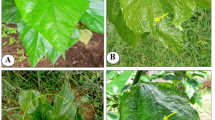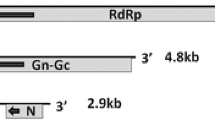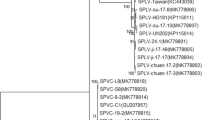Abstract
Hop stunt viroid (HSVd), a member of the family Pospiviroidae, infects a large number of plants and causes substantial economic losses. In this study, HSVd was detected in dappled fruits of sweet cherry and then molecularly characterized. We sequenced 164 cDNA clones from six sweet cherry cultivars in the Shandong Province of China and identified 23 HSVd sequence variants, which ranged in size between 293 and 303 nucleotides (nt) and shared 97~99% sequence identity with each other. Characterization of HSVd variants revealed that three were predominant in sweet cherry trees. Phylogenetic analysis showed that most of the HSVd variants isolated from sweet cherry were clustered within the plum-type group and that two variants were clustered with the recombinant P-C group, regardless of geographic origin. This study identified 23 HSVd variants and provided the molecular characterization of viroid infection (HSVd) in sweet cherry in China.



Similar content being viewed by others
References
Amari, K., Gomez, G., Myrta, A., Di Terlizzi, B., & Pallás, V. (2001). The molecular characterization of 16 new sequence variants of Hop stunt viroid reveals the existence of invariable regions and a conserved hammerhead-like structure on the viroid molecule. Journal of General Virology, 82(4), 953–962.
Amari, K., Ruiz, D., Gómez, G., Sánchez-Pina, M. A., Pallás, V., & Egea, J. (2007). An important new apricot disease in Spain is associated with Hop stunt viroid infection. European Journal of Plant Pathology, 118(2), 173–181.
Astruc, N., Marcos, J. F., Macquaire, G., Candresse, T., & Pallás, V. (1996). Studies on the diagnosis of hop stunt viroid in fruit trees: Identification of new hosts and application of a nucleic acid extraction procedure based on non-organic solvents. European Journal of Plant Pathology, 102(9), 837–846.
Canizares, M. C., Marcos, J. F., & Pallás, V. (1999). Molecular characterization of an almond isolate of hop stunt viroid (HSVd) and conditions for eliminating spurious hybridization in its diagnosis in almond samples. European Journal of Plant Pathology, 105(6), 553–558.
De Rijk, P., Wuyts, J., & De Wachter, R. (2003). RnaViz 2: An improved representation of RNA secondary structure. Bioinformatics, 19(2), 299–300.
Di Serio, F., Flores, R., Verhoeven, J. T., Li, S. F., Pallás, V., Randles, J. W., Sano, T., Vidalakis, G., & Owens, R. A. (2014). Current status of viroid taxonomy. Archives of Virology, 59(12), 3467–3478.
Diener, T. O., Smith, D., Hammond, R., Albanese, G., La Rosa, R., & Davino, M. (1988). Citrus B viroid identified as a strain of hop stunt viroid. Plant Disease, 72, 691–693.
Ding, B. (2009). The biology of viroid-host interactions. Annual Review of Phytopathology, 47(1), 105–131.
Elleuch, A., Hamdi, I., Ellouze, O., Ghrab, M., Fkahfakh, H., & Drira, N. (2013). Pistachio (Pistacia vera L.) is a new natural host of Hop stunt viroid. Virus Genes, 47(2), 330–337.
Flores, R., Hernandez, C., de Alba, A. E. M., Daros, J. A., & Di Serio, F. (2005). Viroids and viroid-host interactions. Annual Review of Phytopathology, 43, 117–139.
Flores, R., Gago-Zachert, S., Serra, P., Sanjuán, R., & Elena, S. F. (2014). Viroids: survivors from the RNA world? Annual Review of Microbiology, 68, 395–414.
Gazel, M., Ulubaș, Ç., & Çağlayan, K. (2008). Detection of Hop Stunt Viroid in sweet and sour cherry trees in Turkey by RT-PCR. Acta Horticulturae, (795, 2), 955–958.
Guo, L., Liu, S., Wu, Z., Mu, L., Xiang, B., & Li, S. (2008). Hop stunt viroid (HSVd) newly reported from hop in Xinjiang, China. Plant Pathology, 57(4), 764.
Hataya, T., Tsushima, T., & Sano, T. (2017). Hop stunt viroid. In A. Hadidi, R. Flores, J. W. Randles, & P. Palukaitis (Eds.), Viroids and satellites (pp. 199–210). San Diego: Academic Press, Elsevier.
Jo, Y., Chu, H., Kim, H., Cho, J. K., Lian, S., Choi, H., Kim, S. M., Kim, S. L., Lee, B. C., & Cho, W. K. (2017). Comprehensive analysis of genomic variation of Hop stunt viroid. European Journal of Plant Pathology, 148(1), 119–127.
Kofalvi, S. A., Marcos, J. F., Canizares, M. C., Pallas, V., & Candresse, T. (1997). Hop stunt viroid (HSVd) sequence variants from Prunus species: Evidence for recombination between HSVd isolates. Journal of General Virology, 78(12), 3177–3186.
Kovalskaya, N., & Hammond, R. W. (2014). Molecular biology of viroid-host interactions and disease control strategies. Plant Science, 228, 48–60.
Lemmetty, A., Werkman, A. W., & Soukainen, M. (2011). First report of Hop stunt viroid in greenhouse cucumber in Finland. Plant Disease, 95(5), 615.
Li, S. F., Guo, R., Tsuji, M., & Sano, T. (2006). Two grapevine viroids in China and the possible detection of a third. Plant Pathology, 55(4), 564.
Lin, C. Y., Wu, M. L., Shen, T. L., Yeh, H. H., & Hung, T. H. (2015). Multiplex detection, distribution, and genetic diversity of Hop stunt viroid and Citrus exocortis viroid infecting citrus in Taiwan. Virology Journal, 12, 11.
Mu, L. X., Wu, Y. H., & Li, S. F. (2009). First report of Hop stunt viroid from almond tree in China. Journal of Plant Pathology, 91(4), 112.
Ohno, T., Takamatsu, N., Meshi, T., & Okada, Y. (1983). Hop stunt viroid: Molecular cloning and nucleotide sequence of the complete cDNA copy. Nucleic Acids Research, 11(18), 6185–6197.
Owens, R. A., Chen, W., Hu, Y., & Hsu, Y. H. (1995). Suppression of potato spindle tuber viroid replication and symptom expression by mutations which stabilize the pathogenicity domain. Virology, 208, 554–564.
Owens, R. A., Steger, G., Hu, Y., Fels, A., Hammond, R. W., & Riesner, D. (1996). RNA structural features responsible for potato spindle tuber viroid pathogenicity. Virology, 222, 144–158.
Rizza, S., Catara, A., Ma, X. F., & Deng, Z. (2007). Detection of multiple infections of Citrus exocortis viroid, Citrus viroid III, and Hop stunt viroid variants in Hunan Province, China. Plant Disease, 91(9), 1205.
Rubio, M., Gómez, E. M., Martínez-Gómez, P., & Dicenta, F. (2016). Behaviour of apricot cultivars against Hop stunt viroid. Journal of Phytopathology, 164(3), 193–197.
Sano, T., & Ishiguro, A. (1998). Viability and pathogenicity of intersubgroup viroid chimeras suggest possible involvement of the terminal right region in replication. Virology, 240, 238–244.
Sano, T., Uyeda, I., Shikata, E., Meshi, T., Ohno, T., & Okada, Y. (1985). A viroid-like RNA isolated from grapevine has high sequence homology with hop stunt viroid. Journal of General Virology, 66(2), 333–338.
Sano, T., Hataya, T., Terai, Y., & Shikata, E. (1989). Hop stunt viroid strains from dapple fruit disease of plum and peach in Japan. Journal of General Virology, 70(6), 1311–1319.
Sano, T., Candresse, T., Hammond, R.W., Diener, T.O., & Owens R.A. (1992). Identification of multiple structural domain regulating viroid pathogenicity. Proceedings of the National Academy of Sciences of the United States of America, 89, 10104–10108.
Semancik, J. S., Roistacher, C. N., Rivera-Bustamante, R., & Duran-Vila, N. (1988). Citrus cachexia viroid, a new viroid of citrus: Relationship to viroids of the exocortis disease complex. Journal of General Virology, 69, 3059–3068.
Shikata, E. (1990). New viroids fron Japan. Seminars of Virology, I, 107–115.
Wang, X. F., Zhou, Y., Li, Z. G., Tang, K. Z., Liu, Y. Q., Cao, M. J., & Zhou, C. Y. (2010). Molecular, biological and phylogenetic analysis of Chinese isolates of Hop stunt viroid associated with citrus cachexia disease. Journal of Phytopathology, 158, 372–377.
Xu, L., Wang, J. W., Zhu, D. Z., Zong, X. J., Wei, H. R., Chen, X., Hammond, R. W., & Liu, Q. Z. (2017). First report of Hop stunt viroid from sweet cherry with dapple fruit symptoms in China. Plant Disease, 101(2), 394.
Yang, Y. A., Wang, H. Q., Guo, R., Cheng, Z. M., Li, S. F., & Sano, T. (2006). First report of Hop stunt viroid in apricot in China. Plant Disease, 90(6), 828.
Yang, Y. A., Wang, H. Q., Cheng, Z. M., Sano, T., & Li, S. F. (2007). First report of Hop stunt viroid from plum in China. Plant Pathology, 56, 339.
Yang, Y. A., Wang, H. Q., Wu, Z. J., Cheng, Z. M., & Li, S. F. (2008). Molecular variability of Hop stunt viroid: Identification of a unique variant with a tandem 15-nucleotide repeat from naturally infected plum tree. Biochemical Genetics, 46(3–4), 113–123.
Zhang, B. L., Liu, G. Y., Liu, C. Q., Wu, Z. J., Jiang, D. M., & Li, S. F. (2009). Characterisation of Hop stunt viroid (HSVd) isolates from jujube trees (Ziziphus jujuba). European Journal of Plant Pathology, 125(4), 665–669.
Zhou, Y., Guo, R., Cheng, Z., Sano, T., & Li, S. F. (2006). First report of Hop stunt viroid from Prunus persica with dapple fruit symptoms in China. Plant Pathology, 55(4), 564.
Zuker, M. (2003). Mfold web server for nucleic acid folding and hybridization prediction. Nucleic Acids Research, 31(13), 3406–3415.
Acknowledgements
This research was supported by Research Funds for Youth of Shandong Academy of Agricultural Sciences (2016YQN25) and Special Found for Fruit Innovation Team of Shandong Modern Agricultural Technology System (SDAIT-06-04).
Author information
Authors and Affiliations
Corresponding authors
Ethics declarations
Conflict of interest
The authors declare that they have no conflict of interest.
Human and/or animals rights
We confirm that in this research any human and/or animals participant was not used and there is no any disagreement with informed consent.
Rights and permissions
About this article
Cite this article
Xu, L., Wang, J., Chen, X. et al. Molecular characterization and phylogenetic analysis of hop stunt viroid isolates from sweet cherry in China. Eur J Plant Pathol 154, 705–713 (2019). https://doi.org/10.1007/s10658-019-01693-3
Accepted:
Published:
Issue Date:
DOI: https://doi.org/10.1007/s10658-019-01693-3




